When it appears on your nose, basal cell carcinoma may look like a thin yellow area, a reddish patch, a clear bump, or an open sore that won’t heal.
Basal Cell Carcinoma Warning Signs
With early detection and treatment, almost all basal cell carcinomas (BCCs) can be successfully removed without complications.
Look out for BCC warning signs, including new, changing or unusual skin growths, so you can spot skin cancers early, when they are easiest to treat and cure.
- How to spot a BCC: five warning signs
- BCCs can be tricky
- What you can do
- Rare skin cancers
- Skin cancer pictures
- Skin Cancer Awareness Toolkit
How to spot a BCC: five warning signs
Check for BCCs where your skin is most exposed to the sun, especially the face, ears, neck, scalp, chest, shoulders and back, but remember that they can occur anywhere on the body. Frequently, two or more of these warning signs and symptoms are apparent in a BCC tumor.
- An open sore that does not heal, and may bleed, ooze or crust. The sore might persist for weeks, or appear to heal and then come back.
- A reddish patch or irritated area, on the face, chest, shoulder, arm or leg that may crust, itch, hurt or cause no discomfort.
- A shiny bump or nodule that is pearly or clear, pink, red or white. The bump can also be tan, black or brown, especially in people of color, and can be mistaken for a normal mole.
- A small pink growth with a slightly raised, rolled edge and a crusted indentation in the center that may develop tiny surface blood vessels over time.
- A scar-like area that is flat white, yellow or waxy in color. The skin appears shiny and taut, often with poorly defined borders. This warning sign may indicate an invasive BCC.
Please note: Since not all BCCs have the same appearance, these images serve as a general reference to what basal cell carcinoma looks like.
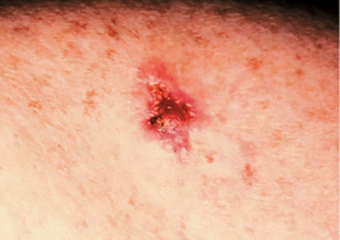
An open sore that does not heal
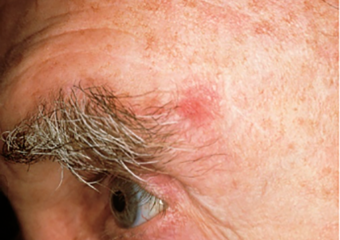
A reddish patch or irritated area
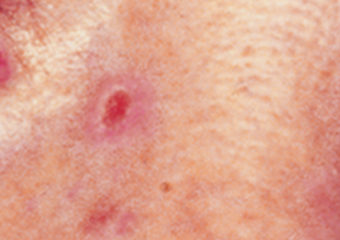
A small pink growth with a slightly raised, rolled edge and a crusted indentation in the center
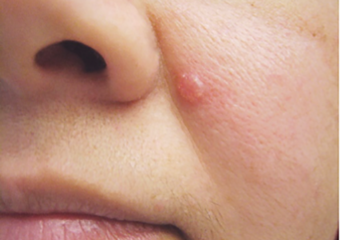
A shiny bump or nodule
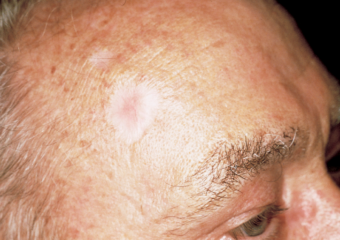
A scar-like area that is flat white, yellow or waxy in color
BCCs can be tricky
Keep in mind that BCCs can look different from the descriptions above. In some people, BCCs resemble noncancerous skin conditions such as psoriasis or eczema. In people with darker skin, about half of BCCs are pigmented (meaning brown in color).
When in doubt, check it out. Follow your instincts and visit your dermatologist if you see anything new, changing or unusual on your skin.
A basal cell carcinoma may be pigmented, like this one, on skin of color. Photo courtesy of Andrew Alexis, MD, MPH
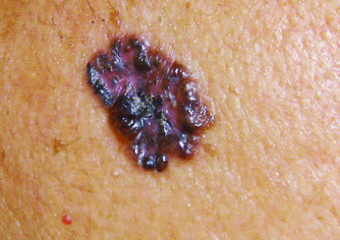
What you can do
If you’ve already had a BCC, you are more likely to develop another, especially in the same sun-damaged area or nearby.
A BCC can recur even when it has been carefully removed the first time, because some cancer cells may remain undetectable after surgery and others can form roots that extend beyond what’s visible. BCCs on the nose, ears and lips are more likely to recur, usually within the first two years after surgery.
Here’s what you can do to detect a recurrence and prevent further skin damage that can lead to cancer:
- Be on the lookout: Pay particular attention to any previously treated site, note changes and consult with your dermatologist. If the BCC does return, your doctor may recommend a different type of treatment, such as Mohs surgery, a highly effective way to prevent and treat recurrences.
- Check yourself head to toe: Look for new or changing lesions that grow, bleed or do not heal. Learn how to check your skin.
- See your dermatologist annually for a professional skin exam. Self-exams do not take the place of a specialist who is skilled at identifying and treating abnormal skin growths.
- Follow up: If you’ve already had either BCC or squamous cell carcinoma (SCC), or a precancer like actinic keratosis, be sure to see your doctor at recommended intervals.
- Be sun-safe every day of the year: Avoid unprotected UV exposure, seek the shade, especially when the sun is strongest and use a broad-spectrum sunscreen, a wide-brimmed hat and UV-blocking sunglasses. Safeguarding yourself every day is the single most effective way to reduce your risk of developing skin cancer. Get more skin cancer prevention guidelines.
Basal Cell Carcinoma of the Nose: Types, Identification, and Treatment
Basal cell carcinomas of the nose are slow growing and treatable if you catch them early. See a doctor if you notice any unusual patches or bumps on your nose, especially if you spend a lot of time outdoors.
Basal cell carcinoma is a type of skin cancer. It can develop on skin areas that have been exposed to the ultraviolet (UV) rays of the sun. This includes your nose.
When it appears on your nose, basal cell carcinoma may look like a thin yellow area, a reddish patch, a clear bump, or an open sore that won’t heal.
Basal carcinoma is slow growing and is typically very treatable. Surgery to remove the tumor is the treatment of choice. Although options such as radiation, immunotherapy, and cryotherapy may also be used.
This article takes a closer look at the symptoms, diagnosis, and treatment of basal cell carcinoma of the nose.
Basal cell carcinoma is a type of skin cancer. About 80% of all skin cancer in people is basal carcinoma. Basal cancers start in the basal cell layer, or surface layer, of your skin.
Basal cell carcinoma grows slowly. Typically, basal carcinoma of the nose can be surgically removed before it spreads to other areas. But if it’s left untreated, it’s possible for the cancer to spread to your bones and nearby tissues.
Types of basal cell carcinoma
There are a few different types of basal cell carcinoma that can develop on your nose. This includes:
- Nodular basal cell carcinoma of the nose: Nodular basal cell carcinomas form clear bumps on your skin surface. Often, blood vessels are visible.
- Sclerosing basal cell carcinoma of the nose: Sclerosing basal cell carcinoma appears as a small white scar that slowly expands.
- Superficial spreading basal cell carcinoma of the nose: Superficial spreading basal cell carcinoma develops on your back more often than it does on other skin surfaces. But it’s possible to develop this type of basal cell carcinoma on your nose. It appears as thin raised patches of skin (called “plaques”) that are close to normal skin color and that expand very slowly.
- Pigmented basal cell carcinoma of the nose: Pigmented basal cell carcinoma is a form of nodular or superficial basal cell carcinoma that appears on darker skin tones. This type of basal cell carcinoma can sometimes be confused with melanoma before a biopsy is done.
Basal carcinoma appears on skin surfaces. Basal carcinoma of the nose appears on the surface area of your nose. When basal cell carcinoma first develops, it can be mistaken for acne, bug bites, moles, or rashes. Symptoms of basal cell carcinoma to be aware of include:
- reddish patches on your nose
- itchy patches
- small, clear, and shiny bumps that might have blue, brown, or black areas in them
- flat and firm areas that are pale or yellow and resemble scars
- open sores that don’t heal or that heal and come back
- pink growths with raised edges and visible blood vessels that resemble spokes in a wheel
- bumps that bleed easily
Basal cell carcinoma can appear differently depending on the exact type and your skin tone. You can see examples of basal cell carcinoma in the image gallery below.
There’s no way to 100% predict basal carcinoma of the nose. But, as is the case with all skin cancer, it’s known that exposure to UV light is the most significant risk factor. UV light damages your skin and, over time, can lead to cancer. Additional risk factors for basal cell carcinoma of the nose include:
- tanning bed use
- repeated sunburns
- having a fair or light-skinned complexion
- exposure to arsenic and certain other chemicals
- exposure to radiation from previous cancer treatments
- having skin cancer in the past
- having an inflammatory skin condition
- having a weakened immune system
- having human papillomavirus (HPV)
- smoking
As is the case with most types of cancer, the risk of basal cell carcinoma of the nose increases with age. People assigned male at birth are also at a slightly higher risk than those assigned female at birth. But this is thought to be because many jobs traditionally held by people assigned male at birth involve sun or radiation exposure.
Preventing basal carcinoma of the nose
You can take steps to protect yourself and lower your risk of developing basal cell carcinoma of the nose. Strategies include:
- Limit your exposure to UV rays.
- Avoid tanning beds.
- Stay in the shade when possible.
- Wear sunscreen and reapply sunscreen every 2 hours.
- Wear wide-brimmed hats.
- Wear sunglasses with UV protection.
- Avoid areas where you might be exposed to harmful chemicals.
- Quit smoking.
- Check your skin regularly for any bumps, redness, or unusual growths.
The first step in getting treatment for basal cell carcinoma of the nose is to make an appointment with a doctor or healthcare professional if you notice any unusual skin discolorations or bumps on your nose.
A doctor will ask you about your symptoms. For example, they may ask when you first noticed anything unusual on your nose. They’ll also ask you about your history of sun exposure and about any family history of cancer.
For the physical portion of the exam, they’ll examine the area you suspect might be cancer. They might also check nearby areas, such as your lymph nodes, which can swell if the cancer has spread.
A skin biopsy will be done to determine if the area is cancer. In some cases, the entire area is removed during the biopsy. This sometimes resolves basal cell carcinoma of the nose before a final diagnosis has been confirmed.
In other cases, a tiny sample of the area will be taken and sent to a lab for testing. Either way, a doctor will use a small surgical tool to complete the procedure.
Treatment for basal cell carcinoma of the nose depends on the size, type, and location of your cancer. The most common treatment is surgery to remove the tumor. During a surgical procedure, a doctor will remove the cancerous area and might also remove some of the healthy skin around it to ensure it doesn’t grow back.
Sometimes, a special kind of surgery called Mohs’ surgery is done. During Mohs’ surgery, skin in the affected area is removed one layer at a time. Each removed layer is then checked for cancer. Layers are removed until all cancerous layers are gone.
If surgery can’t be done, or if further treatment is needed, you might also have:
- Radiation therapy:Radiation therapy can kill cancer cells and shrink tumors. It can help treat tumors and can help stop the spread of cancer.
- Cryotherapy:Cryotherapy uses freezing temperatures to shrink and destroy small tumors.
- Superficial tumor treatment: Tumors that are very close to the surface of your skin can sometimes be treated with methods such as topical chemotherapy, photodynamic therapy, or immune response modifiers .
- Immunotherapy:Immunotherapy is a specialized treatment that helps your immune system find and destroy cancer cells.
The outlook for people with basal cell carcinoma of the nose is generally positive.
According to the American Cancer Society , about 5.4 million Americans receive a diagnosis of any type of basal cell or squamous cell cancer every year. It’s also estimated that around 2,000 Americans die from any type of basal or squamous cell cancer each year. That’s about 0.004%.
Most cases of death from basal cell carcinoma of the nose occur when people have suppressed immune systems or when their cancer isn’t treated until it has spread.
Basal cell carcinomas develop on the surfaces of your skin, including the surface of your nose. Basal cell carcinomas are the most common type of skin cancer. But they’re also typically treatable.
In most cases, basal cell carcinoma of the nose can be removed during surgery. Sometimes, basal cell carcinoma can even be removed during a skin biopsy test, resolving the cancer before a diagnosis is even given.
When treatment beyond surgery is needed, options such as radiation, cryotherapy, and immunotherapy are available.
Last medically reviewed on January 4, 2023






